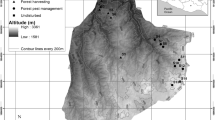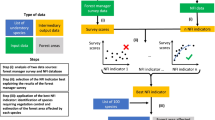Abstract
The effects of trampling on the understorey vegetation were studied in boreal urban forests of different fertility in the greater Helsinki area, Finland. The three studied forest types in decreasing order of fertility were: 1) herb-rich heath forest, 2) mesic heath forest, and 3) sub-xeric heath forest. We inventoried the cover percentages of understorey vegetation in 40 herb-rich, 75 mesic and 40 sub-xeric biotopes located in 51 urban forests varying in size (0.6–502 ha). Cover percentages were compared to those of untrampled reference areas. In our study, trampling tolerance increased with increasing fertility of the forest type. Wear of understorey vegetation correlated positively with the number of residents (i.e. recreational pressure) around the forest patch. In general, understorey vegetation cover in all three forest types was lower than in the same forest types in untrampled reference areas. Ground layer cover in urban forests was less than half of that in reference areas. Mosses, lichens, and dwarf shrubs, especially Vaccinium vitis-idaea, proved to be sensitive to trampling and consequently decreased in cover. The cover of tree saplings, mainly Sorbus aucuparia, and some resilient herbs increased.


Similar content being viewed by others
References
Ahti T, Hämet-Ahti L, Jalas J (1968) Vegetation zones and their sections in northwestern Europe. Ann Bot Fenn 5:169–211
Andren H, Angelstam P (1993) Moose browsing on Scots Pine in relation to stand size and distance to forest edge. J Appl Ecol 30(1):133–142
Arnberger A (2006) Recreation use of urban forests: An inter-area comparison. Urban Forestry and Urban Greening 4:135–144
Bobbink R, Hornung M, Roelofs JGM (1998) The effects of air-borne nitrogen pollutants on species diversity in natural and semi-natural European vegetation. J Ecol 86:717–738
Busby JR, Bliss LC, Hamilton CD (1978) Microclimate control of growth rate and habitats of the boreal forest mosses, Tomenthypnum nitens and Hylocomium splendens. Ecol Monogr 48:95–110
Cajander AK (1926) The theory of forest types. Acta For Fenn 29(3):108 pp
Callaghan TV, Collins NJ, Callaghan CH (1978) Photosynthesis, growth and reproduction of Hylocomium splendens and Polytrichum commune in Swedish Lapland. Oikos 31:73–88
Chen J, Franklin JF, Spies TA (1993) Contrasting microclimates among clearcut, edge and interior of old-growth Douglas-fir forest. Agric For Meteorol 63:219–237
Cole DN (1987) Effects of three seasons of experimental trampling on five montane forest communities and a grassland in Western Montana, USA. Biol Conserv 40:219–244
Cole DN (1995) Experimental trampling of vegetation. II. Predictors of resistance and resilience. J Veg Sci 32(1):215–224
Cole DN, Bayfield NG (1993) Recreational trampling of vegetation: standard experimental procedures. Biol Conserv 63:209–215
Dirkse GM, Martakis GFP (1992) Effects of fertilizer on bryophytes in Swedish experiments on forest fertilization. Biol Conserv 59:155–161
Florgård C (2000) Long-term changes in indigenous vegetation preserved in urban areas. Landscape Urban Planning 52:101–116
Florgård C, Forsberg O (2006) Residents’ use of remnant natural vegetation in the residential area of Järvafältet, Stockholm. Urban Forestry and Urban Greening 5(2):83–92
Guirado M, Pino J, Rodà F (2006) Understorey plant species richness and composition in metropolitan forest archipelagos: effects of forest size, adjacent land use and distance to the edge. Global Ecol Biogeogr 15:50–62
Gundersen V, Frivold LH, Löfström I, Jørgensen BB, Falck J, Øyen B-H (2005) Urban woodland management – the case of 13 major Nordic cities. Urban Forestry and Urban Greening 3:189–202
Hamberg L, Lehvävirta S, Malmivaara-Lämsä M, Rita H, Kotze DJ (2008) The effects of habitat edges and trampling on understorey vegetation in urban forests in Helsinki, Finland. Appl Veg Sci (in press)
Hammitt WE, Cole DN (1998) Wildland recreation: ecology and management. John Wiley and Sons, New York, 361 pp
Hautala H, Tolvanen A, Nuortila C (2001) Regeneration strategies of dominant boreal forest dwarf shrubs in response to selective removal of understorey layers. J Veg Sci 12:503–510
Hämet-Ahti L, Suominen J, Ulvinen T, Uotila P (eds) (1998) Retkeilykasvio [Field flora of Finland]. Finnish Museum of Natural History, Botanical Museum, Helsinki
Hiirsalmi H (1969) Trientalis europaea L.: a study of the reproductive biology, ecology and variation in Finland. Ann Bot Fenn 6:119–173
Huggard DJ, Vyse A (2002) Edge effects in high-elevation forests at Sicamous Creek. Silviculture. Extension note 62, 1–8. Ministry of Forests, Forest Science Program, British Columbia
Jaatinen E (1973) Recreational use of Helsinki’s forests. Folia For 186
Jonsson BG (1993) The bryophyte diaspore bank and its role after small-scale disturbance in a boreal forest. J Veg Sci 4:819–826
Kellomäki S (1973) Ground cover response to trampling in a spruce stand of Myrtillus type (in Finnish with English summary). Silva Fenn 7(2):96–113
Kellomäki S (1977) Deterioration of forest ground cover during trampling. Silva Fenn 11(3):153–161
Kellomäki S, Saastamoinen V-L (1975) Trampling tolerance of forest vegetation. Acta For Fenn 147:1–22
Kellomäki S, Wuorenrinne H (1979) On factors effecting on deterioration of urban forests (in Finnish with English summary). Silva Fenn 13(2):177–183
Koponen T (1994) Lehtisammalten määritysopas [Moss identification guide]. Helsingin yliopiston kasvitieteen laitoksen monisteita 139, Helsinki
Kullman L (1986) Temporal and spatial aspects of subalpine populations of Sorbus aucuparia in Sweden. Ann Bot Fenn 23:267–275
Kuuluvainen T (1994) Gap disturbance, ground microtopography, and the regeneration dynamics of boreal coniferous forests in Finland: a review. Ann Zool Fenn 31:35–51
Kuusipalo J (1983) Distribution of vegetation on mesic forest sites in relation to some characteristics of the tree stand and soil fertility. Silva Fenn 17(4):403–418
Kuusipalo J (1985) An ecological study of upland forest site classification in southern Finland. Acta For Fenn 192:1–77
Kuusipalo J (1996) Suomen metsätyypit [Forest site types of Finland]. Kirjayhtymä, Helsinki
Lahti T, Väisänen RA (1987) Ecological gradients of boreal forests in South Finland: an ordination test of Cajander’s forest site type theory. Vegetatio 68:145–156
Lehtilä K, Syrjänen K (1995) Compensatory responses of two Melampyrum species after damage. Funct Ecol 9:511–517
Lehvävirta S (1999) Structural elements as barriers against wear in urban woodlands. Urban Ecosyst 3:45–56
Lehvävirta S, Rita H (2002) Natural regeneration of trees in urban woodlands. J Veg Sci 13:57–66
Liddle MJ (1975) A theoretical relationship between the primary productivity of vegetation and its ability to tolerate trampling. Biol Conserv 8:251–255
Liddle MJ (1997) Recreation ecology: The ecological impact of outdoor recreation and ecotourism. Chapman & Hall, London
Littlemore J, Barker S (2003) The ecological response of forest ground flora and soils to experimental trampling in British urban woodlands. Urban Ecosyst 5:257–276
Malmivaara-Lämsä M, Fritze H (2003) Effects of wear and above ground forest site type characteristics on the soil microbial community structure in an urban setting. Plant Soil 256:187–203
Malmivaara M, Löfström I, Vanha-Majamaa I (2002) Anthropogenic effects on understorey vegetation in Myrtillus type urban forests in southern Finland. Silva Fenn 36(1):367–381
Mäkipää R (2000a) Pleurozium schreberi. In: Reinikainen A, Mäkipää R, Vanha-Majamaa I, Hotanen J-P (eds) Kasvit muuttuvassa metsäluonnossa [Changes in the frequency and abundance of forest and mire plants in Finland since 1950], Tammi, Helsinki, pp 251–253
Mäkipää R (2000b) Hylocomium splendens. In: Reinikainen A, Mäkipää R, Vanha-Majamaa I, Hotanen J-P (eds) Kasvit muuttuvassa metsäluonnossa [Changes in the frequency and abundance of forest and mire plants in Finland since 1950], Tammi, Helsinki, pp 248–250
Mäkipää R (2000c) Brachythecium-suku. In: Reinikainen A, Mäkipää R, Vanha-Majamaa I, Hotanen J-P (eds) Kasvit muuttuvassa metsäluonnossa [Changes in the frequency and abundance of forest and mire plants in Finland since 1950], Tammi, Helsinki, pp 238–239
Mikola P (1985) The effect of tree species on the biological properties of forest soil. National Swedish Environmental Protection Board, Rapport 3017, 27 pp
Nylund M, Nylund L, Kellomäki S, Haapanen A (1979) Deterioration of forest ground vegetation and decrease of radial growth of trees on camping sites. Silva Fenn 13(4):343–356
R Development Core Team (2005) R: A language and environment for statistical computing. R Foundation for Statistical Computing, Vienna, Austria. ISBN 3-900051-07-0, URL http://www.R-project.org
Roovers P, Verheyen K, Hermy M, Gulinck H (2004) Experimental trampling and vegetation recovery in some common forest and heath communities. Appl Veg Sci 7:111–118
Rydgren K, Hestmark G, Økland R (1998) Revegetation following experimental disturbance in a boreal old-growth Picea abies forest. J Veg Sci 9:763–776
Sievänen T (1987) Experiences of forest recreation in another culture: A comparison between Finland and Minnesota. Scand For Econ 29:49–56
Thimonier A, Dupouey JL, Timbal J (1992) Floristic changes in the herb-layer vegetation of a deciduous forest in the Lorraine Plain under the influence of atmospheric deposition. For Ecol Manag 55:149–167
Tolvanen A, Laine K (1997) Effects of reproduction and artificial herbivory on vegetative growth and resource levels in deciduous and evergreen dwarf shrubs. Can J Bot 75:656–666
Tolvanen A, Forbes B, Rytkönen K, Laine K (2001) Regeneration of dominant plants after short-term pedestrian trampling in subarctic plant communities. In: FE Wielgolaski (ed) Nordic mountain birch ecosystems, pp 359–368. Man and the Biosphere Series Volume 27, UNESCO, Paris, and Parthenon Publishing, Carnforth
Tonteri T (2000) Melampyrum pratense. In: Reinikainen A, Mäkipää R, Vanha-Majamaa I, Hotanen J-P (eds) Kasvit muuttuvassa metsäluonnossa [Changes in the frequency and abundance of forest and mire plants in Finland since 1950]. Tammi, Helsinki, pp 202–204
Tonteri T, Hotanen J-P, Mäkipää R, Nousiainen H, Reinikainen A, Tamminen M (2005) Metsäkasvit kasvupaikoillaan-kasvupaikkatyypin, kasvillisuusvyöhykkeen, puuston kehitysluokan ja puulajin yhteys kasvilajien runsaussuhteisiin [Forest plants and forest site types]. Metsäntutkimuslaitoksen tiedonantoja 946:1–106
Tyrväinen L, Silvennoinen H, Kolehmainen O (2003) Ecological and aesthetic values in urban forest management. Urban Forestry and Urban Greening 1:135–149
Wade TG, Riitters KH, Wickham JD, Jones KB (2003) Distribution and causes of global forest fragmentation. Conserv Ecol 7(2):7. [online] URL: http://www.consecol.org/vol7/iss2/art7/
Weathers KC, Cadenasso ML, Pickett STA (2001) Forest edges as nutrient and pollutant concentrators: potential synergisms between fragmentation, forest canopies, and the atmosphere. Conserv Biol 15:1506–1514
Zerbe S (2001) On the ecology of Sorbus aucuparia (Rosaceae) with special regard to germination, establishment and growth. Polish Bot J 46:229–239
Acknowledgements
We thank Eeva Karjalainen for her constructive comments on the manuscript. The study received financial support from the Finnish Biodiversity Research Programme (FIBRE, project 48010) and from Maj and Tor Nessling Foundation.
Author information
Authors and Affiliations
Corresponding author
Rights and permissions
About this article
Cite this article
Malmivaara-Lämsä, M., Hamberg, L., Löfström, I. et al. Trampling tolerance of understorey vegetation in different hemiboreal urban forest site types in Finland. Urban Ecosyst 11, 1–16 (2008). https://doi.org/10.1007/s11252-007-0046-3
Received:
Accepted:
Published:
Issue Date:
DOI: https://doi.org/10.1007/s11252-007-0046-3




